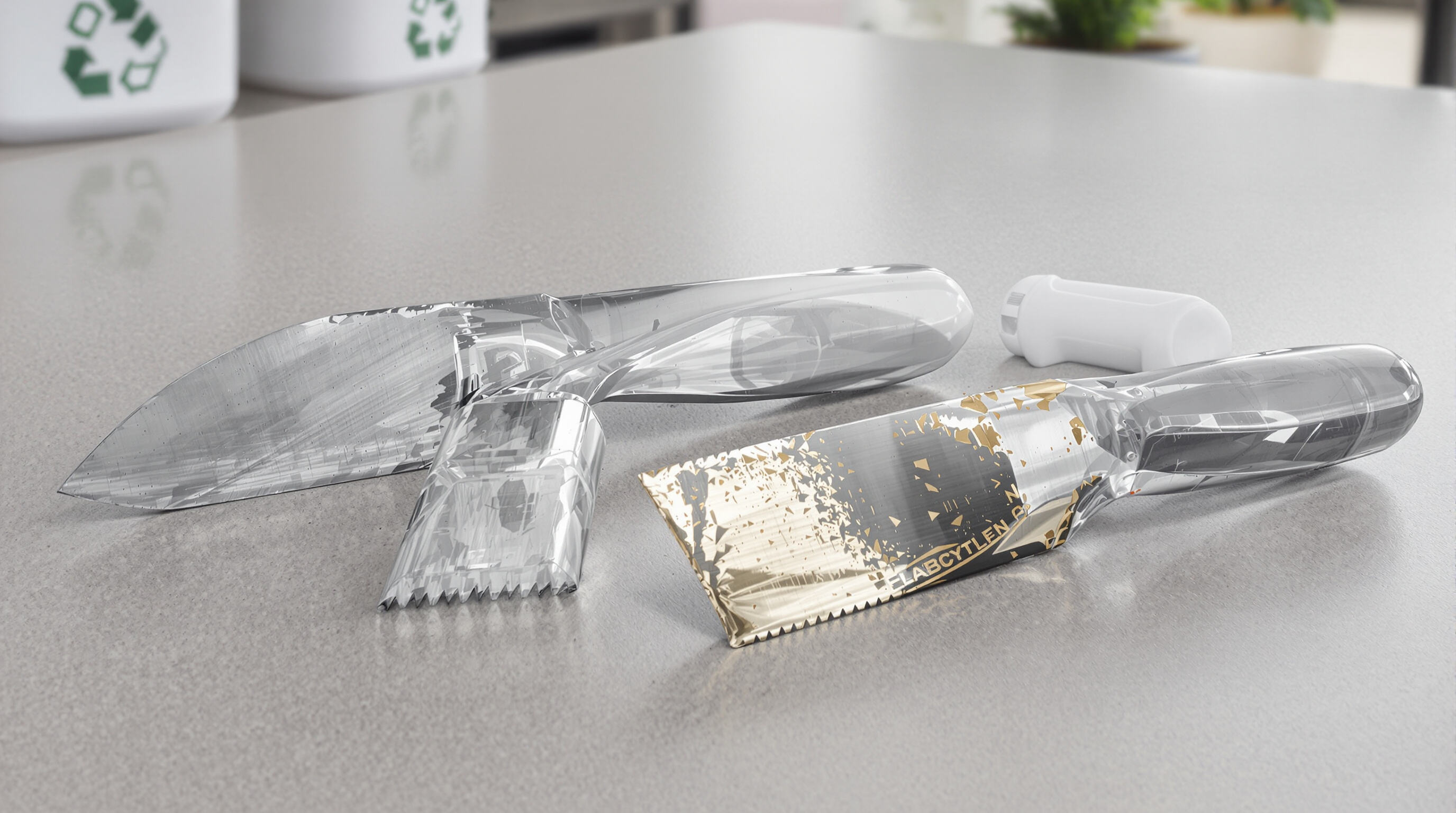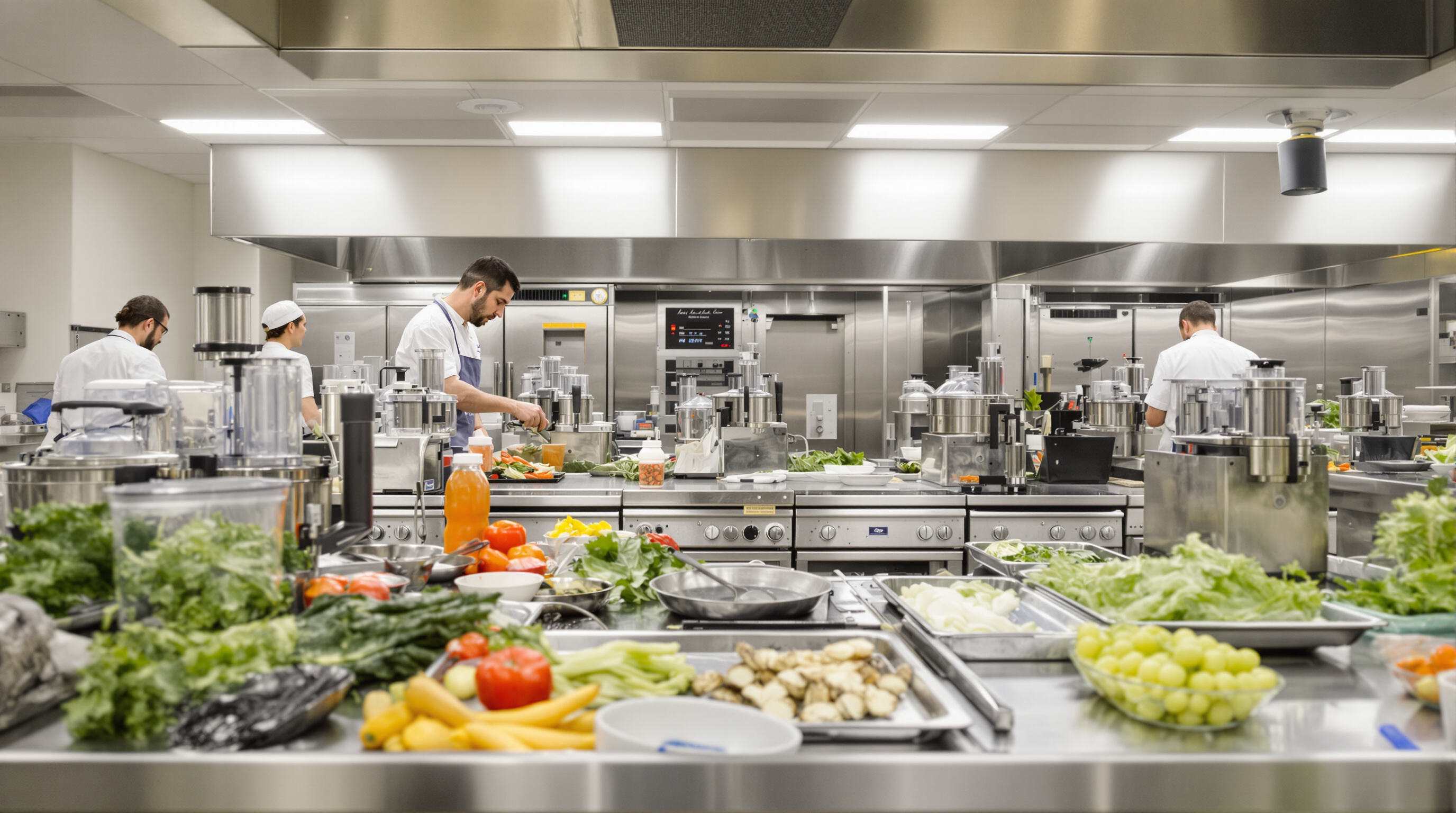Nuntii
Legendo Dexteram Cibum Praeparatorum Lamae pro Ecologicis Cibis Praeparandis
De Culinae Machinae Lama: Functiones et Effectus Sustinibilis
Genera Culinae Machinae Laminae et Eorum Officia in Prandia Sustinibiliter Paranda
Molae ad cibum conficiendum sunt instructae diversis laminis quae tria principalia negotia agunt: scindere, râdere, et concidere cibum. Haec instrumenta specialia coquendum faciliorem reddunt quia certis rebus melius inserviunt quam unam lamnam ad omnia cogere. Exempli gratia, lamina ad radendum vegetabilia parare potest fere dimidio brevius quam manu secare, ut quaedam experimenta anni superioris docuerunt. Et vere, nemo iam cupit suum mixtorem manualem extrahere cum de massa panis conficienda cogitatur. Molae novae cum discis ad râdendum reversibilibus et multis usibus laminarum vere adiuvant minuere numerum instrumentorum quae in cucina nostra locum occupant. Aliquot homines affirmant postquam ad haec utilis instrumenta conversum est, fere dimidio pauciora utensilia sibi necessaria esse, quod loci spatium et rationem electricitatis etiam minuit.
Quomodo Laminae Forma Minuit Cibi Perditos et Meliorem Facit Rationem Electricitatis
Laminae factae cum ratione praecisionis et acuminibus incisis radiophotice praecidunt cibos aequabilius quam vulgares aut obtusae, quod minus cibus cotidie abjiciatur. Numeri quoque hanc sententiam confirmant - quaedam studia ostendunt remissionem circiter 22% quando tales laminae qualitativae utuntur. Alius bonus usus est superficies sectiles inclinatae quae re vera cibum per machinam melius agunt, minuendo laborem motoris circiter 15% pro singulis partibus elaboratis. Recentior inspectio operum culinariorum a NSF facta anno 2023 invenit loca quae ad haec meliora ac disposita laminae conformia corpori humano commutaverunt mensurate circiter 8 kilowatt-horas singulis mensibus conservatas, quia celerius omnia agebantur. Recte sane, optimus modus non solum rem meliorem efficit, sed etiam monetam et vires conservare iuvat tempore longiore.
Munus Laminae Efficientis in Aedibus Coquinaria et Domestica
Laminae efficientes magnam partem in culinis agunt quae nituntur ad nihil perdendum. Tabernae quae in instrumenta specialia pro diversis negotiis investiunt tendunt ad circa 40% minus ingredientium amittendum cum magnas quantitates parant. Domi vero laminae cum sensu aciei sapienti usque ad triplum diutius durare solent quam aliae. Recens inquisitio ab Initiativa Culinaria Viridis monstravit plusquam septem ex decem magistris culinariis dicere has lamina meliores sese adiuvare ad virides metas attingendas sine compromissione qualitatis cibi. Hoc est cur tantae tabernae vertant ad illos qui sapientius secant et diutius durant.
Materiae Laminae et Diuturna Beneficia Environmentalia

Ferrum inox vs. laminae plasticae: Durabilitas, recyclabilitas, et impactus vitae
Quod attinet ad sostenibilitatem, ferrum inox securius omnino praestat plastico in pluribus partibus. Culter ex ferro inox factus acutus manet circiter 15 000 sectionum priusquam iterum acuendus est, dum plures cultelli plastici suum acumen amittere incipiunt post solum circiter 5 000 usus, ut recentes studia de sostenibilitate culinae ex proximo anno docent. Quod fit in fine vitae eorum etiam omnem differentiam facit. Plastica cultellorum materia solet colligi in compitulis ubi saeculis opus est ut dissolvatur, at vero ferrum inox liquefactum iterum et saepius reuti potest absque qualitate amissa. In conspectu rerum maioris, studia indicant ferrum inox cultellos circiter duas tertias minorem emissionem carbonis producere per vitam suam, quamvis computentur facta quod initio plures opes ad fabricandam ferrum requirantur. Qui cupit minuere sordes in culina sua, cultris ex ferro inox multo magis propter rem esse poterit diuturne.
Cur laminae e ferro inox solvant sordes in solo minus triplo tempore usus
Ferrum inox diutius durat quam plasticum ut sordes minuantur notabiliter. Plurima lamina plastica iterum substitui debent priusquam unum laminam ferream curari oportet. Cum in cibariis et aliis negotiis spectamus, hoc annis singulis circiter 480 libras plasticorum minus in sordes soli significat pro unaquaque machina. Ad numerum illum perspiciendum, hoc est quasi duodecim milia plasticiarum communium vasis sordidum effossarum omnino prohibere, secundum relationem Associationis Nationalis Cibarii anni praeteriti. Quod haec laminae metallicae tam diu manent, etiam minus vestimentorum inutilium fit. Praeterea, fere 45% in expensis energiae conservatur cum pauciores substitutiones fiunt, quod quod fortis esse videtur tandem in emolumenta vera ambientalia vertit.
Aestimando laminae 'eco-coatae' non-tenaces: An vere sustentabiles sint?
Cum in speculis non-stick videmus options virides, oportet nos altius cavare antequam res sumamus. Materia PTFE haec chemicales noxios PFC liberat cum disrumpitur, quod vere laesionem infert ei quod de ecologia dicitur. Nonnullae tamen ceramicae plantarum origine non habent hunc defectum, sed vere homines narrant eas post menses lavandi solvi. NSF International nuper in hunc locum ingressa est creando normas pro revestiendis quae vere 200 usus ferunt sine ruina. dishwasher iunctura chalybis inoxydabilis cum una harum certificatarum a NSF praesentis videri solet optima ratio pro iis qui serio de sustentabilitate cogitant. Sine dubio plus pecuniae constat initio, sed emolumenta diuturna tam pro coquinaria quam pro salute planetae consideranda sunt.
Cultelli ad Prandia Comparanda ut Nihil Rejiciatur
Secare, tritare, et raspare: Culter idoneus pro Cunctis Rerum Generibus in Machina Praeparandi Ciborum eligendus
Laminae sectionis specializatae vere augent modum quo res in culinis efficeiuntur. Cum coqui laminae sectionis ad certas res accomodatae utuntur, multo constantiores effectus consequuntur. Hoc circa 15-20% cibum, qui nimis coctus vel parum coctus est, minuit. Pro rebus ut pomis amoris quae solent rumpi dum secta sunt, laminae secantes in modum transversum omnem differentiam faciunt. Methodi traditae circa 10% substantiae poma amoris durante praeparatione amittunt. Raspera ad cibos duros accommodata circa 20% plus substantiae ex caseis duris et radicibus extrahunt quam homines manu assequi possunt. Laminae certi generis eligere iusta est quia fragmenta inaequalia circumjecta drastice minuit. Et hoc rationem habet, si ad quae apud Agentiam Protectionis Environmentalis inventa sunt de meliore controlatione portionum ducentis ad minus inutilis in culinis professionalibus spectatur.
Pars plantarum meliorata cum adiunctis variis et ad certas res accommodatis
Cucinae ad plantas spectantes bonas adiunctiones adhibent ad cum difficilibus legumis versari. Laminae julianae valent ad zucchini in tenuia vermicelli vertenda sine multo legumi perditis, et hi disci canaliculati vere facere possunt ut legumina deformia in assis acceptabiliora videantur. Est etiam quoddam quod cruciferorum triturator dicitur, qui omnia illa fragmenta quae homines solent iactare tractat - cogita de caulis kales aut stipitibus broccoli quae vere copiam nutrientium continent sed saepe reiiciuntur. Secundum quasdam relationes ab UNEP prolatae, ad cibum plantarum conversio perditum cibum totalem circiter 34 percentualiter minuere posset. Cum coqui his specialibus laminae in armamentario suo habent, vere omnem partem cuiuslibet legumi per portam introducti uti possunt.
Exemplum: Taberna sine perditis cibis produxit 40% magis cum rotatione stratagema laminae
Serie cauponarum sustinibilis mirabiles emendationes efficentiae per obtinuit rotando lamas secundum cotidianas praeparationis necessitates:
| Metricus | Antequam Rotatae | Postquam Rotatae | Melioratio |
|---|---|---|---|
| Cibum cotidianum eductum | 120 portionum | 168 portionum | +40% |
| Lactucae recisae damnum | 31% | 18% | -42% |
| Praeparationis tempus per kilogramma | 22 minuta | 14 minuta | -36% |
Collocando tempus rasurae radicis matutino et sectio exacta salsa vespere, caupona minuit usum laminarum et fluxum electricitatis. Haec machinalis iunctura aeque utilis erat ac materiae electae ad sostenibilitatem augendam.
Optimizare Efficienciam et Sostenibilitatem in Magna Ciborum Praeparatione

Tempus et energiam paranda per systemata rotorum optimizata in coquendis cibis metiendi
Configuratae speciales rotorum praeparationem vegetabilium tempore minuunt 53 minuta in mediam singulis diebus in coquinis publicis, energiam 18% reducendo (Institutum Culinariae Sustentabilis 2023). Operationes magnae quantitatis 27% celerius productum efficiunt motore minus sollicitato, ad sustentandos metas sustentabilitatis sine amissione quantitatis.
Cognitiones ex indagine: 1 200 coqui domi et professionales de actu rotoribus et usu
Indagatio 1 200 artificum culinariae monstravit 73% praecipue intermutabilitatem rotorum quaerere ad remotionem duplicatae machinae. Conclusio pricipalis est:
- Rotoribus specialibus multifariis usus resupplendum dimidiatum
- Loca ergonomica tutetatem augent in mutationibus celeribus
- Fittinges universales emptionem novae machinae minuunt 38%
Haec elementa efficacitatem et sustentabilitatem in variis locis culinariis augent.
Ars sagittae sapientis: Quomodo cognitio novae generationis meliorat sustentabilitatem processuum
Systemata intelligente nunc detegunt densitatem frugum et celeritatem automate moderantur, praeventione praecipua super-processus per 31%, texturae et nutritamentis conservatis. Cultrae cum RFID inter se cum Systematibus Rerum Coquinariae (KMS) utensia rationem usus habent et signa praemonentia necessitatem mendingendi antequam fractio eveniat, aetatem machinae prolongantes et repositiones inopinatas minuentes.
Ratio: Rotatio cultrorum ad longevitatem augendam et repositiones minuendas
Rotatio cultrorum ex temporibus fixis longevitatem partium auctam per 220% secundum commentarios de officinis productionis. Exempli gratia, conservare cultrum tesserificum ex ferro inox pro solis radicibus vegetabilium fere triplicat aetatem eius contra alternativas multiplices usus. Haec ratio minuit contributiones ad sordidaria et tenuit summitatem efficacitatis sectandi per tempus.
Designatio et Effectus: Aequilibratio Potentiae, Efficacitatis, et Conservationis Nutritamentorum
Laminae altius performantes vs. super-processing: Nutritionem in eco-culinis retinendo
Laminae acutae cibum secant cum minore destructione cellularum, quod adiuvat ad plures nutrientes integros retinendos et processum brunneum tardandum. In recenti investigatione ab Instituto Technicorum Alimentorum anno 2023 facta, culinae quae eorum aequipamenta sectiva emendaverunt videre circa 15% meliorem vitaminorum conservationem in vegetabilibus post sectionem. Haec laminae etiam celerius operantur, itaque minuunt consumtionem electricitatis et cibum diutius sapore fresco conservant. Pro culinariis qui culinam salutarem vel amicam ambientis administrant, hoc omnem differentiam facit ad valorem nutritionalem et efficaciam operativam tempore retinendam.
Laminae designatae cum minore frictione quae laborem motoris et consumtionem energiae minuunt
Geometriae hydrodynamicae et superficies speculatores resistentiam operativam minuunt, vim motricemque circiter 18% per partem dimiuunt. Haec etiam desinent minus calorem generare, vitam motricis et laminarum usque ad triennium prolongant. In locis ubi multum utuntur sicut in aedificiis ciborum parandorum, haec aequabilitas in perpetuis emolumentis conservationis consistit.
Innovationes in structura processorum cibi ad minimum impetum ambientalem
Novissima eorum systematum aetate venit cum cartuccis ex ferro inoxidable quae separari et recyclari possunt, praeterea cum specialibus tectis quae natura dissolvuntur praeterquam microplasticas relinquentes. Investigatores sollicite laborant versionibus solariter motis quae cum systematis recyclandi aquae consentiunt. Sperant has novas formas usum aquae circiter 80% infra antiquas methodos paucis annis minuere. Quod hic videmus est fere completa ratio qua producta a prima usque ad ultimam fabri debent cogitari. Haec meliora resultata summae qualitatis servat dum multo minori vestigio in nostro ambiente relicto antiquis technologiis.
FAQ
Quae sunt quaedam genera cultrorum in tritatoribus ciborum?
Tritatores ciborum plerumque cum cultris pro sectando, minuendo, radata, et tritura variis ingredientibus ad certas magnitudines vel constantias veniunt.
Cur ferrum inoxibile pro cultris sicut amicum ambientis aestimatur?
Laminae ex ferro inoxidable diutius durant, recyclari possunt, et eorum fabricatio in minoribus emissionibus carbonis concludit quam alternativis plasticis.
Quomodo laminae speciales ciborum inutilitatem minuunt?
Fornendo sectiones constantes, laminae speciales minimas particulas inaequales reducunt quae saepe reiciuntur, ita ciborum inutilitatem minuunt.
 Post-Sales:
Post-Sales:
 EN
EN
 AR
AR
 HR
HR
 NL
NL
 FI
FI
 FR
FR
 DE
DE
 EL
EL
 HI
HI
 IT
IT
 PT
PT
 RO
RO
 RU
RU
 ES
ES
 TL
TL
 ID
ID
 SL
SL
 VI
VI
 ET
ET
 MT
MT
 TH
TH
 FA
FA
 AF
AF
 MS
MS
 IS
IS
 MK
MK
 HY
HY
 AZ
AZ
 KA
KA
 UR
UR
 BN
BN
 BS
BS
 KM
KM
 LO
LO
 LA
LA
 MN
MN
 NE
NE
 MY
MY
 UZ
UZ
 KU
KU









